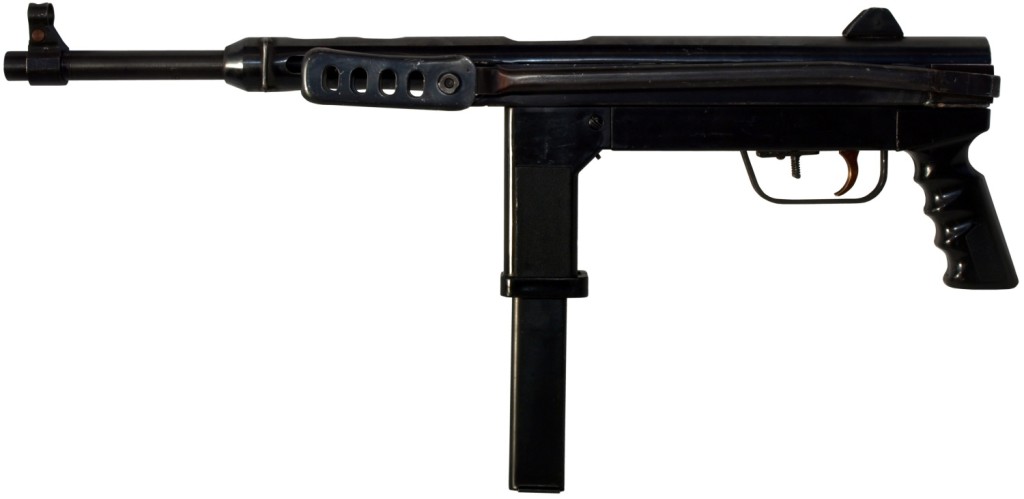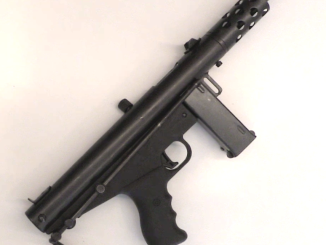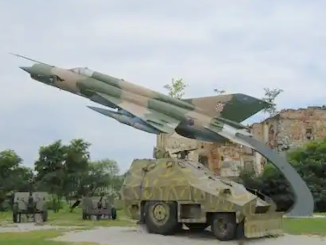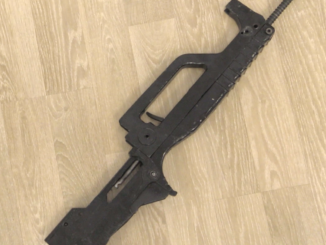Today’s gun was made quite recently, but also pretty obscure – I had not heard of it until Michael Heidler sent us this description and set of photos:
Improvised firearms and mines dominated the early stages of the struggle for an independent Croatia in the early 1990s. In the absence of appropriate equipment, machinery and tools, the weapons were mostly made in an “antiquated” manner of production: machined from a solid block of material instead of using stamped sheet metal parts. Although this method is time consuming, it can be performed in small workshops with simple machines.

A technically simple weapon was the MP Šokac (named after a Croatian dialect). It is a copy of the Russian PPSh 41 from the Second World War, but the caliber was changed to 9 mm Parabellum. The milled receiver can be opened by pressing a button on its back. The upper receiver holds the bolt that was cribbed from the PPSh 41. The bolt is completely identical with the Russian pattern including the buffer made of pressed material and the safety on the cocking handle.

In front of the trigger frame there is a sliding selector (full auto and single shot) of the same type as the PPSh-41. The frequently encountered folding buttstock is copied from the Czech submachine gun SA vz. 25.The straight magazine holds 25 rounds.

The first test of the Šokac took place on 15th August 1991. From then on several variations were produced, depending on the manufacturer, various available materials, with short or long barrels, and with or without a flash suppressor. The “luxurious” model with plastic paneling was given the suffix “P 1” and the version with silencer “P 1 S”. The main producer of MP Šokac was Đuro Đaković in Slavonskli Brod.
Check out all 15 photos:
[nggallery id=185]




Used here:
http://en.wikipedia.org/wiki/Battle_of_Vukovar
Very similar in concept to the North Vietnamese K50M of the Vietnam War.
I love these types of weapons. It’s always such a pleasure to see the fruits of necessity made manifest.
While trying to avoid comments related to tragic period of Yugoslav history, I must say that have great admiration for Croatian small arms creativity. They started from nothing and they have currently their own rifle and pistol with international reputation. These transition period SMG have, albeit crude by some measure, interesting aspects to them. One thing which may be questioned: why not common issue 7.62×35 Tok. round was not used? Was it because of genuine Croatia’s reliance on assistance from West?
I meant certainly 7.62×25; should better proof-read before post. I hope somebody will be able to put some ligh on the issue of caliber choice.
Another interesting Croatian adaptation of an existing design is the PHP MV-17, also in 9mm: https://www.buymilsurp.com/croatian-php-mv17-9×19-pistol-p-41575.html
Disregard that link. Here are the short (MV-9) and long (MV-17) versions of the pistol: https://www.buymilsurp.com/surplus-handguns-gallery-croatia-handgun-gallery-c-3075_3078_10213.html
Forgot to mention: the above guns are derived from the Walther P38.
Ironically, if the receiver and sundry other parts of the Sokac SMG were machined from solid billet out of necessity, it probably turned out to be a better-quality gun than its already largely bullet-proof immediate ancestor. Of course, this is assuming that all else was equal, i.e., similar ( or tighter ) tolerances and fit-up were maintained, and any minor changes to the design were carefully integrated so as not to negatively impact the reliability and functionality of the weapon.
As a follow-up to my previous comment, is there any hard information on the Sokac’s reliability and general battlefield performance? Denny is absolutely right about this weapon, among others, being the unfortunate progeny of a tragic war — and history is rife with similar inventions stemming from brutal necessity.
Sorry, only info I have is from several people who used these during the war. Over here everyone knows someone who served during the war, unfortunately.
Most of these people were pleased with these weapons. No wonder, since they were almost straightforward copies of other successful SMGs.
When there were enough small arms smuggled/captured, most of these SMGs were destroyed, since there were enough AKs, G3s, Argie FALs and Singaporean guns to go around.
Thank you for answering my inquiry — your efforts and candor are very much appreciated, and the information you have supplied is still quite insightful. From the tone of your posts, I am going to assume, unless otherwise corrected, that you live and work in Croatia. It is so good to see the region settling down and moving forward after the terrible wars of the 1990’s. The vainglorious ambitions of the kind of men who start wars and destroy the lives of others with no forethought or consideration for humanity should be locked away forever, along with those who would engender them.
Wishing You, Your Family and Your Community Peace and Prosperity,
Earl
How very true. 🙂
Although, considering how Europe of 2013 is starting to look like the Europe of 1933, I don’t think we’re out of the woods yet.
The Sokac is an iconic weapon with the Sokci Croats,
http://en.wikipedia.org/wiki/Battle_of_Osijek
The cheapo deactivated guns:
http://www.dekowaffen-tuerk.com/viewpage.php?page_id=2
Awww, this is better:
http://www.dekowaffen-tuerk.com/viewpage.php?page_id=160
@Denny: 7,62 Tokarev was not exactly the most common pistol/SMG caliber in former Yugoslavia. The range of bullet calibers used by the army and the police was… interesting, to say the least. Tokarev was as common as 9 mm Para.
I did not know that; thank you sir!
It actually does not surprise me that much since I remember that pretty well all in former Federative Yugoslavia was of mixed influences and origins – consumer goods, way of life and even banking.
True, that. Old SFRY tried to get the best of both worlds. 🙂
Although, there is also an important fact that I forgot: regular army and police used mostly Warsaw Pact ammo, but reserve police force and Home Army used a huge amount of captured guns from WWII. Most of these (like Beretta SMGs and MP40s) were chambered in 9 mm Para. There were huge stocks of this ammo in local arms storehouses.
Again, thanks for your response. This definitely adds to my general (today sort of obsolescent) knowledge. I visited SFRY twice before leaving Europe, so I know what you talk about; it was beautiful land and peoples.
Hi Ian, thanks for this article, (and to those who gave additional info in the posts above). Seems odd that there so little (English) information out there on the SMGs from that part of the world. I can’t seem to find much on the “Pleter 91”; the “Zagi M91”; the “Stipe Alar”; the “Jelen”; and the “Agram” series at all.
Yes, info on these guns is rather scarce, but I guess that it’s because these guns are not very interesting. They are a bit like the SMGs of Spanish Civil War: costly guns, well made by skilled craftsmen. But not very optimized for mass production and completely unoriginal.
All of them are copies of mass-produced, very successful SMGs: Sten, Beretta PM12, Uzi and Yugo M56.
Thanks for your reply. Yeah, that seems to be a good summary of what I’ve found so far — I even read somewhere that many of these burp-guns were made to take whichever type of magazine was most common in the area, whether Beretta, Uzi or whatever. Yes, I doubt any of these SMGs brought anything especially new to the table, but they each had a unique story behind them. I suppose the interest, for me, lies in the “how and why” of the design decisions taken by desperate people in desperate circumstances. For example, the “Zagi” appears to have a polymer lower, which is quite unusual for an SMG of the period — was it simply that they had polymer-forming facilities close to hand? Why were there no shoulder-stocks on the Agram series, when a simple folding stock would have made them so much more viable as weapons? Were these things designed to see a lifetime of use, or were they just semi-disposable weapons to allow a conscript to hose-down an enemy soldier and take his rifle? Semi-auto settings? Safety devices? Numbers built? ROF? Performance in combat? All hard to find info.
My apologies for this late reply, but real life has a nasty way of interfering with one’s interests. 🙂
There are no sources in English (or no that I know of), only those in Slavic gobbledygook. These two are the most informative (when put through Google Translate):
http://www.mup.hr/main.aspx?id=150279 (from online Museum Of Ministry of Internal Affairs)
http://www.hrvatski-vojnik.hr/hrvatski-vojnik/1232007/strojnice.asp (from a Croatian military magazine)
Of course, translation is atrocious, but it can be useful.
Considering your other questions, here are a few quickie answers:
These guns were made to last – there are no Jungle Workshop Stens here.
When they were designed they were supposed to use existing facilities and materials and that is the cause of many odd solutions. Some, like Agram, were made for CQB _only_ (a Poor Man’s MP5K, if you will). It has no shoulder stock and it can be equipped with a sound suppressor.
Others, like Pleter, were designed with general battlefield use in mind. Other data can be found on these two websites.
It’s also impossible to verify the amount of produced guns – it’s considered State Secret. Approximations range from “few hundreds” to “several thousands”. Almost all companies that made these guns are long gone and their products “found their way” from police and army stocks into criminal hands. It’s a matter of acute embarrassment for Croatian government. :/
“Why was 9mm caliber used” ?
Primarily because all of these 1991 “homemade” (in fact almost all of them made in local full industrial workshops and factories – Đuro Đaković made m84 tanks!) used rifled 9mm barrels freely bought on meters in Austria (unlike the normal weapons), because it was the only part that the croatian factories could not made quickly and reliably, as they did not had the machinery and know-how. They bought meter of so called “raw” barrel, cut it and made out of it 4-5 Smg’s, that was the practice.
@Micki Mahoney
” I even read somewhere that many of these burp-guns were made to take whichever type of magazine was most common in the area, whether Beretta, Uzi or whatever”
This is very common internet misconception, stemming from one foreign article full of BS, about Pleter if I recall correctly. The Croatian producers made their own magazines, based on the mp38(Zagi) or Uzi, and the copy of Uzi mag is mostly common (for example in Pleter and Crogar).
Speaking of Šokac, since it uses double stack-single feeding, first made magazines were 30 or so rounds, but they found them to be too long (long as Sten/Mp38 magazines), so they shortened the magazine to Uzi magazine length, and ended up with 25 rounds.None of this would happen if they used Uzi magazine in the beginning, since its double stack-double feed configuration offers the same round capacity as single feed ones, but in smaller package.
Šokac is fairly well made, but since it’s a more or less straight copy, has the downsides of Ppsh41 – extremely high rate of fire, coupled with domestic innovation of not so great magazine capacity.
As for the name, “Šokac” (Š= Sh, as in english word “Sure”) is the colloquial, local name for the man (or people “Šokci”) from that region of eastern Croatia, called Slavonia. “Ero” for example (cro. Uzi) is a colloquial name for a croatian man from Hercegovina region (part of Bosnia&Herzegovina)
The great role these weapons had in boosting the morale and national proudness, is reflected that all of them have some kind of a popular and unique name, and are not called by some letter and number nomenclature (Pleter, Zagi, Pauser, Vila Velebita, Agram, Ero etc. etc.)
Storm, the additional information is much appreciated. I learned a lot. And thanks for laying to rest that Internet myth about the supposed hodge-podge of non-standardized magazines in Croatian service.
@Micki
“Seems odd that there so little (English) information out there on the SMGs from that part of the world. I can’t seem to find much on the “Pleter 91″; the “Zagi M91″; the “Stipe Alar”; the “Jelen”; and the “Agram” series at all.”
There is not much info not only on english, but in croatian also about all these domestic weapons 1991-1995. manufacture period, but believe me, beside common known and usually mentioned weapons (Pleter, Zagi, Šokac, Ero, Agram) there are at least 10 more that are not known publicly so far.
The “explosion” of all these domestic designs could be thanked to the fact that Croatia had pretty strong industrial basis in the former Yugoslavia (unlike today), and while not having ANY weapons or munitions factories, common goods factories had the machinery and skilled workers that could switch to wartime production, more or less sucessfull. There were lot of factories with machines shops (especially near the frontline) who all tried to cobble up something for the war cause (bombs, single shot shotguns,mortars, simple smgs etc.) – often unofficially, not endorsed or financed by the offical government. People often spontaneusly organised themselves for defence, as they seen the brutal war progress and that it is the time for; “Now or never”. That kind of national boost and solidarity was not seen ever afterwards the war.
If some brave and (un)lucky person is to wrote a book on all of these weapons and stories behind them, it could have at least 300 pages, and great deal of it would be so far unique, unseen information.
It would be a terrible shame if it all ends up forgotten.
As for “Stipe Alar”, it is not the name of smg, but of its maker, name of smg is only “Alar” (Stipe is male name, Alar is surname). He made the guns in some workshop, with the help of the young students from local machining high school. Probably not more than few hundred were made. Supposedly there is also improved version of Alar, but it was never made past the protoype, or maybe even exists only on blueprints.
“Jelen” is not domestically croatian made smg, but cut down and shortened Ppsh41, so it technically could not fall directly into the same category of croatian submachineguns.
Storm, both you and DebeliMacak seem to have the most insight into Croatian firearms and the situations that gave rise to them, and Big Al, Denny and Fidel Feederle are also quite knowledgeable. You could collectively put together a comprehensive history of these weapons for publication.
@Earl Liew
I have some knowledge on that topic, maybe more than the most of usual domestic and foreign gun nutties, but it is far from the whole picture, unfortunately.
There are some people who know more about it, and even have collections of various rare guns from that period, but as happens often with collectors, they keep it selfishly for themselves, indirectly working for the myths and untrue stories, rather then clearing it.
Especially sad thing is that the employees of various museums that house some of the rare guns, often know nothing about it, or are mostly uninterested in the story behind them, not to mention the lack of any common gun knowledge.
Everybody, check this out : http://www.mup.hr/UserDocsImages/muzej/zbirke/oruzje/sokac_v.jpg
This is the “deluxe” version of Šokac, made as a gift in the suitcase, for some local oil smuggler and war profiteer. It’s chrome plated, along with the silencer, 4 magazines, sling and cleaning kit.
These gift kits were given by the ĐĐ plant to various individuals who helped the gun production.
Supposedly from what I’ve heard, silencers (suppressors) had a habit of their aluminum baffles falling out as the user shooted the gun.
I’m sorry to hear that there are people whom you are probably acquainted with who are holding out for reasons of self-interest, which probably means that the preservation and archiving of a valuable historical record could be be lost in time. However, keep in mind that while they may currently know a little more than you do about Croatian weapons because of this advantage, you still know a lot ( as far as I can tell ) and you also have one priceless advantage over them — an open mind that is willing to learn and share. No one person or group of persons knows every single thing about a given topic, and it is usually those who are open-minded and unselfish yet critical in their thinking who will gain more knowledge in the long term.
That was an interesting link you posted — it reminds me somewhat of the fancy gold-plated and jewel-encrusted personal guns sometimes seized from very well-to-do Mexican, Colombian and other drug smugglers. “Entrepreneurs” frequently seem to feel compelled to show off to the rest of the world in one form or the other how successful they have become, and drug lords are no different. Aside from the obvious status issues, personal insecurity is probably sometimes part of the equation too. Of course, it’s a different story if the customized gun was voluntarily given as a true token of appreciation to a patron or patriotic contributor who never asked for anything in return :).
Hi everybody,
it’s great to see how my little contribution to Forgotten Weapons has caused a nice discussion 😉
From time to time these guns show up on the collectors market in Germnay (but deactivated of course). There was nothing to find in the literature and so I began to do a lot of research on the Croatian submachine guns. But for me as a German it was hard to get in contact with people there. It took a lot of time and finally I was able to writen an article for Small Arms Review. The only two helpful people were Miroslav Kavur of the company “Kavur N&M” and Željko Jamičić of the Police Museum in Zagreb (a big thanks to them from my side!) Nevertheless I have found out more than I had expected.
But Storm, you are right. Someone should write a book! But I guess it would be a job for a Croatian 😉
With best wishes
Michael
Speaking of rare info, there is also a pump-action Spas 15 style shotgun that ĐĐ plant made in 1991, but only in a prototype form, no serial pruduction.
http://www.hrvatski-vojnik.hr/hrvatski-vojnik/3452011/bpictures/slika%201%20samarica%20%20SV.jpg
Domestic independent gun producers really loved shotguns, as they do not need rifled barrels.
There are probably hundreds of variations of single shot shotgun-pistols, interestingly barrels were made from one particular car driving wheel seamless shaft, that was “ideal” for 16 gauge shell.
These shotgun pistols surely didn’t mean a lot on the regular battlefield, but more as a last resort self defense weapon for close range situations.
@GGG
I haven’t yet seen the article from Small Arms Review, please tell what submachine guns you discussed in the article ?
Speaking of museums, Police museum is not having permanent presentation, they ship out their gun collections only on some occassions, like Day of the Armed Forces.
There is also a “Military museum” with supposedly heaps and heaps of materials from the war (even a collection of improvised armored vehicles), exisiting for quite a time (at least 10 years), but also even more notorious than Police museum; no exhibition of anything anywhere (?!)
They even had a burglary few years ago, when somebody stole a dozen of (subm.)guns from their firearms collection…
@Storm
Please send me an email to GGBuch@gmx.de
Thanks
Michael
DebeliMacak, Storm and GGG, thanks for all this info! And I agree with the others, there ought to be a book about this stuff, if any of you have the time and inclination. Perhaps, over time, those involved in the production and the more “private” collectors will be more willing to talk about it.
Thanks again,
MM
Are there any magazines out there for these? There was 90 kits imported in 2016 with no more coming into the U.S. But no one has come up with a working magazine yet that I know of. Any help would be appreciated. The Uzi magazine and Sten are too large even cutting a sten down the front and folding it over and welding closed again will not work. Someone said a madsen m50 could be made to work but that has a proven unsuccessful also.